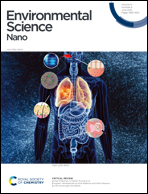Elucidating the origin of the toxicity of nano-CeO2 to Chlorella pyrenoidosa: the role of specific surface area and chemical composition†
Abstract
With the increasing environmental application and discharge of nano cerium dioxide (nano-CeO2), it is urgent to fully understand its ecotoxicological effects on the aquatic environment. This study, for the first time, compared five nano-CeO2 types with different sizes and morphologies: nano-spheres (3 nm, CNSs), nano-octahedra (7 nm and 25 nm, CNOs-7 and CNOs-25, respectively), nano-cubes (50 nm, CNCs), and nano-rods (173 × 8 nm, CNRs) to explore the origin of the toxicity to a freshwater alga (Chlorella pyrenoidosa) systematically. Scanning electron microcopy images show that CNSs, CNOs-7 and CNRs were more readily able to hetero-agglomerate with algal cells than CNOs-25 and CNCs. The direct physical contact between algal cells and nano-CeO2 and the consequent release of Ce3+ ions at the bio-nano interface might account partially for the observed toxicity, which was demonstrated by the increased intracellular reactive oxygen species (ROS), changes in levels of superoxide dismutase (SOD), malondialdehyde (MDA), and mitochondrial membrane potential (MMP) loss and X-ray absorption near edge spectroscopy (XANES) analysis, respectively. Moreover, all the nano-CeO2 could adsorb nutrient elements from the aquatic medium, causing nutrient depletion and subsequent inhibition of cell growth with a significant difference among the five nano-CeO2 types (35.7% for CNSs (total growth inhibition was 53.0%), 33.7% for CNOs-7 (55.2%), 11.9% for CNOs-25 (22.6%), 14.4% for CNCs (22.6%) and 33.1% for CNRs (59.1%)), suggesting that nutrient depletion is the most important factor that causes algal cell growth inhibition. A correlation analysis suggests that the specific surface area (SSA) is an important parameter influencing the toxicity of nano-CeO2 to algae. On the other hand, when comparing CNRs and nano-CePO4, although their morphologies were similar, their toxicities were different, with the latter being non-toxic to algae, indicating that the toxicity is chemical composition dependent. This work provides important information for revealing the toxic mechanisms and environmental risks of different nano-CeO2 in the aquatic environment.



 Please wait while we load your content...
Please wait while we load your content...